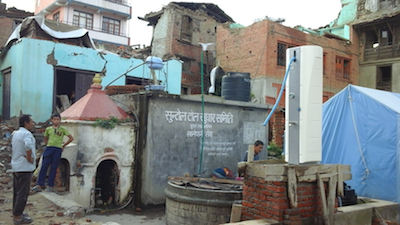Villagepump 500 Standard
The Villagepump 500 yields at least 500 litres of fully purified, safe drinking water per hour, and meets WHO standards regarding removal of bacteria, viruses and turbidity. Each Villagepump employs multi-stage filtering that reduces diseases by removing waterborne pathogens that can cause diarrhoea, dysentery, cholera and hepatitis. The units can operate from all forms of surface water, including ponds, lakes and streams. Clean water for everyone, everywhere!
The Villagepump 500 is ideal as a compact mobile water treatment system wherever fresh surface water is available or with water storage systems (e.g. rainwater harvesting). To be used for an off-grid water supply and/or aid relief in case of natural disasters. Communities of up to 300 people can be served with drinking water through one unit.
Contents
Suitable conditions
| Advantages | Disadvantages |
|---|---|
| - 500 liter safe, clean drinking water per hour - WHO standard water quality regarding removal of viruses, bacteria, cyst and turbidity |
- The Villagepump does not remove dissolved salts or chemical contamination. |
The Villagepump 500 Standard should be kept at a maximum distance from water source of 10 meters and/or a maximum static head of 3 meters.
- Once operational, the unit needs to be protected against freezing
- Ambient temperature: min. +1o C, max. 50 C
- Feed water temperature: +3o C, max. 35 C
|
|
Operations and maintenance
Smart filtering
Filtering is performed in two (or more, but optional) stages:
- Pre-filtering: the inlet filter (50 micron) prevents most colloidal parts to enter the unit.
- Ultra filtering: this technology is based on membrane techniques removing bacteria, viruses, protozoa and cysts, while still allowing vital minerals to pass through. The membrane filter employs self-cleaning ‘smart valves’ (backwash).
- Optional Activated Carbon Filter restores the water’s flavor, color and taste.
- An add-on absorption filter (ZirconiumOxide) removes dissolved Arsenic, Fluoride, Iron and Manganese.
Periodically the built-in chlorine dispenser can be used to clean the membrane filter and internal piping as an extra precaution.
Other features:
- No external fossil fuel and or electrical power source needed
- No vulnerable and theft-prone (electronic) components
- No weather dependant components (ie. solar panels)
- Height: 1730 mm
- Width: 500 mm
- Depth: 620 mm
- Weight: approx. 80 kg
Villagepump 500 is fully mechanical and hand-powered, using proven technology and without any vulnerable electronics. The use of robust materials gives an expected life span of approximately 5 years, providing 500 – 700 M3 of safe drinking water every year. Villagepump 500 is easy to maintain and user-friendly.
The lifetime of the ultra filtration membrane is 1 - 3 years depending on water source quality. The optional Activated Carbon Filter needs to be replaced about every three months. The optional ZrO2 absorption filter has to be replaced every 6 – 9 months depending on the concentration of dissolved metals. The Villagepump needs to be cleaned periodically (once every 4 weeks). Ultra filtration membrane, feed pump seals, and valve have to be replaced once every 1 – 3 years. This can be done by local staff based on instructions from the O&M manual.
Costs
| Captial Cost | Operation Cost | Replacement Cost | Estimated 5 years Cost | Cost/liter treated |
|---|---|---|---|---|
| Approximately € 3.500 (EXW the Netherlands) | Approximately € 250 per year | Approximately € 6.000, including shipment, agent and import costs | Approximately € 7.250 (Capex and Opex) | € <0.002 |
Manuals, videos, and links
Company Information
Villagepump BV, Lisdoddelaan 80, 1087 KA Amsterdam
Phone: 020-6200958
Email: info[at]villagepump.org
Web: www.villagepump.org

